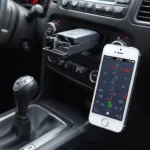Understanding how to read OBD2 live data is crucial for anyone who wants to diagnose car problems effectively. This guide provides a comprehensive overview of OBD2 live data, from basic definitions to advanced interpretation techniques. We’ll explore how to use this data to pinpoint issues, optimize performance, and save money on car repairs.
Understanding OBD2 Live Data
OBD2, or On-Board Diagnostics II, is a standardized system that allows external devices to access a vehicle’s diagnostic information. Live data, a key component of this system, is real-time information streamed directly from your car’s various sensors. This data offers a dynamic snapshot of your vehicle’s performance, providing insights that static diagnostic trouble codes (DTCs) often can’t.
By learning how to read OBD2 live data, you gain the power to:
- Diagnose problems more accurately: Live data reveals how different systems interact, offering clues that DTCs alone might miss.
- Monitor vehicle performance: Track crucial parameters like fuel efficiency, engine timing, and transmission performance in real time.
- Prevent future issues: Identify developing problems early on by observing trends and deviations in live data.
- Save money on repairs: Armed with detailed information, you can make informed decisions about repairs and avoid unnecessary replacements.
Choosing the Right OBD2 Scanner
Not all OBD2 scanners are created equal. Some offer basic code reading capabilities, while others provide access to a wealth of live data parameters. When choosing a scanner, consider factors like:
- Data parameters supported: Ensure the scanner supports the specific live data you need to access.
- Live data graphing: Graphing capabilities allow you to visualize data trends over time, making analysis easier.
- User interface and ease of use: A clear and intuitive interface can significantly enhance your diagnostic experience.
- Compatibility: Confirm that the scanner is compatible with your vehicle’s make, model, and year.
 OBD2 scanner displaying live graph data
OBD2 scanner displaying live graph data
obd2 live data normal reading offers valuable insight into expected readings.
How to Access and Interpret OBD2 Live Data
Accessing live data is typically straightforward:
- Locate your vehicle’s OBD2 port (usually under the dashboard).
- Plug in your OBD2 scanner.
- Turn on the ignition (without starting the engine).
- Select the “Live Data” option on your scanner.
Interpreting the data requires some knowledge of vehicle systems and their corresponding parameters. Many scanners provide definitions and normal ranges for common parameters. Don’t hesitate to consult online resources or repair manuals for more in-depth information.
Common Live Data Parameters
Here are a few crucial live data parameters and what they can tell you:
- Engine RPM: Indicates engine speed.
- Coolant Temperature: Shows the engine’s operating temperature.
- Oxygen Sensor Voltage: Reflects the oxygen content in the exhaust gases, indicating fuel mixture richness or leanness.
- Manifold Absolute Pressure (MAP): Measures the air pressure inside the intake manifold, reflecting engine load.
- Throttle Position Sensor (TPS): Indicates the position of the throttle plate, reflecting how much air is entering the engine.
obd2 ii eobd car ms509 diagnostic code reader live data provides a good overview of the information available.
Troubleshooting with OBD2 Live Data
Live data becomes invaluable when troubleshooting specific problems. For example, if your car is experiencing rough idling, you can monitor live data parameters like RPM, MAP, and oxygen sensor voltage to pinpoint the cause. By observing fluctuations and deviations from normal ranges, you can identify potential issues like vacuum leaks, faulty sensors, or ignition problems.
how to read live data on a obd2 scanner helps you get the most out of your device.
“Live data provides a dynamic view into your vehicle’s inner workings, allowing you to diagnose complex problems much more efficiently than with DTCs alone.” – David Miller, Automotive Diagnostics Specialist
Conclusion: Mastering OBD2 Live Data
Learning how to read obd2 live data empowers you to take control of your car’s maintenance and repair. By understanding this valuable information, you can diagnose problems more accurately, monitor performance effectively, and ultimately save time and money.
FAQ
- What is OBD2 live data? (Live data is real-time information from your car’s sensors.)
- Why is live data important? (It helps pinpoint problems and monitor performance.)
- How do I access live data? (Use an OBD2 scanner plugged into the diagnostic port.)
- What are some common live data parameters? (RPM, coolant temperature, oxygen sensor voltage, MAP, TPS.)
- How can I interpret live data? (Compare readings to normal ranges and look for deviations.)
- Where can I find more information about specific parameters? (Online resources and repair manuals.)
- What should I look for in an OBD2 scanner? (Support for relevant parameters, graphing capabilities, user-friendliness, compatibility.)
obd2 code reader with live data and tpns can provide more information about TPMS and live data.
read and understand live data from obd2 is a valuable resource for further reading.
For support contact WhatsApp: +1(641)206-8880, Email: [email protected] or 789 Elm Street, San Francisco, CA 94102, USA. We have a 24/7 customer support team.
